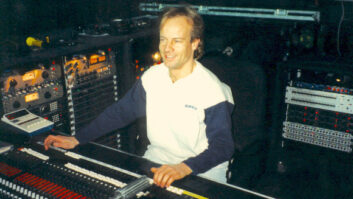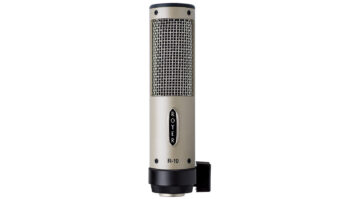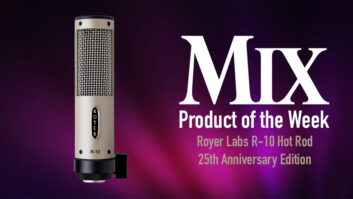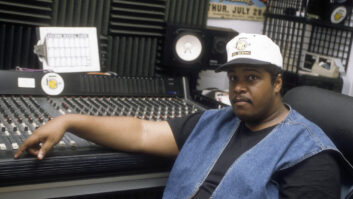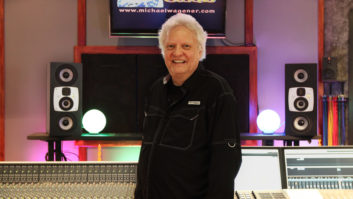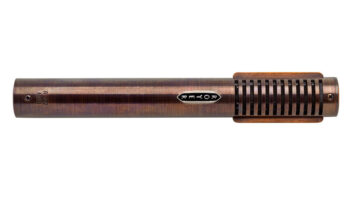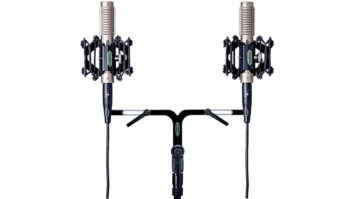Image of Justin Stanley.
Los Angeles, CA… From the time he was a student in school, Justin Stanley knew he wanted to record and engineer music. “I started with a TASCAM Portastudio 244,� he says, “and spent every day recording something. Years later, I joined a band that went on to sign a record deal. I then found myself in a ‘proper’ studio—sitting behind the producer and engineer while trying to learn as much as I could without bugging the hell out of them.� From that point on, it’s been a steady climb that has led Stanley to his present level of success: engineering the latest Eric Clapton recording “CLAPTON�, with the help of his Royer Labs microphones.
As a producer, engineer, and musician, Justin Stanley has been integral to a number of high profile music projects and his Royer mics have been right there with him. “I first discovered Royer mics when I was engineering and mixing the soundtrack for the film Friday Night Lights,� said Stanley. That soundtrack served as a template for a lot of sports documentaries and the TV series of the same name. I used as many Royer R-121’s as I could get my hands on and used them on everything.�
Since that time, Stanley has used Royer Labs microphones on every session he’s been involved with, including the recent Sheryl Crow release “100 Miles From Memphis�, which he co-produced with Doyle Bramhill II and engineered. Other recent successes include vocalist Nikka Costa’s 2008 release ‘Pebble to a Pearl’ on Stax Records, British musician/vocalist Jamie Lidell’s ‘Jim’, on the Warp Records label, as well as a project with two-time Grammy® Award winner Ben Harper—for an album of collaborations that has an eclectic mix of artists, including Tricky, Brendon Flowers (the Killers), Rob Thomas, and several other artists re-interpreting INXS songs. This record is scheduled for release in late 2010.
Stanley’s Royer microphone arsenal includes an R-121 Mono Ribbon microphone, two R-122 Active Ribbon microphones, and an SF-24 Stereo Active Ribbon microphone. He reports that his R-121 is his favorite for miking guitar cabinets, though he also uses them on hi-hats and ride cymbals when he needs extra detail from the drum kit. He also uses his two R-122 microphones for recording drums.
“The R-122’s have been my choice on the toms,� Stanley said. “I really like a puffy sounding tom that still has lots of detail. With the R-122, they sound like they’ve hit the tape [recorder] and been compressed a little. In the right position, you can get away with two of these mics, a kick and a snare mic, and you’re done. I usually place the R-122’s four to five inches away from the tom on a slight angle.�
Of all his microphones, Stanley has a clear preference for his Royer SF-24V. “The SF-24V is an amazing microphone,� he explained. “It’s my new discovery. I recorded a 23-piece string section at AIR studios for the Clapton record and ended up using just three mics—two Neumann M50’s as a spaced stereo pair and the SF-24V sitting behind the conductor positioned at a height of about eight feet. The SF-24V pulled the strings towards me like they were being sucked to the front of the speakers. The detail is amazing. Once I heard what the SF-24V was capable of, I used it on everything from Allen Toussaint’s piano, a B3 organ, as well as a New Orleans brass band. I also love the sound of the SF-24V when used just out in front of a drum kit. Find the sweet spot, and you can pull up two faders and have an incredible drum sound.�
Stanley says of CLAPTON, “I think a lot of people will really dig it. The record has a certain rawness to it, offers a really diverse collection of songs with lots of organic dusted out sounds, and the playing is ridiculous—not in a flashy way, but in the way it grooves. This record is more about the collective feel between the musicians and what’s best for the song. Most of the recording was captured live at Oceanway Studios and my Royers played a big role in this project.�
Before heading back to the studio, Stanley offered a few final comments about his Royer Labs microphones. “One thing I love about Royer ribbons is that they always respond favorably to being EQ’d and they never sound shrill,� Stanley said. “They’re a great complement in this digital world. There’s nothing better than pushing up less than 24 faders on a console and having the whole song there. For some reason to my ears, it just lets everything breathe better. When you use one mic that you can capture the sound you’re after—without using ten of them—then you’re in a good place. That’s why I use Royer ribbons.�
For additional information about Justin Stanley, contact him via email at [email protected].
About Royer Labs
Located in Burbank, California, Royer Labs’ microphones are a staple of leading recording and broadcast facilities. Additional information on the entire line of Royer Labs microphones and other aspects of the company can be found at www.royerlabs.com.
###
